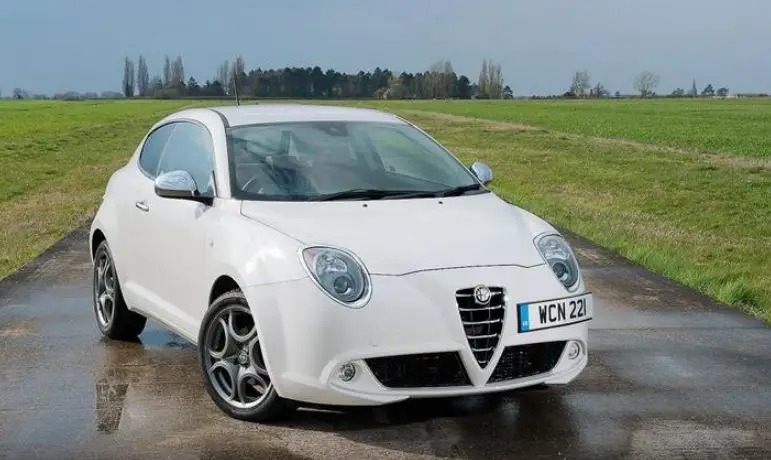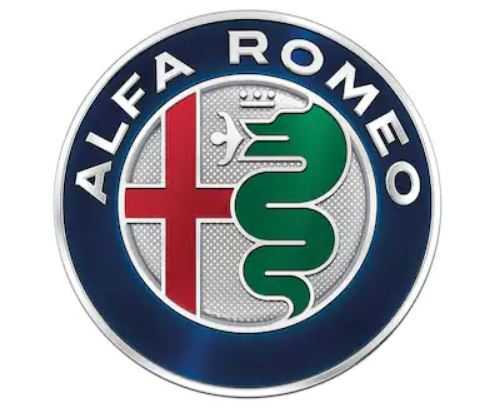2015 Alfa Romeo MiTo Seat Belt Instructions
Safety features that are both basic and necessary are built into the 2015 Alfa Romeo MiTo. These are the seat belts. In order to keep the driver and passengers safe, the MiTo’s seat belts are made to protect them in the event of a crash or quick stopping. However, they are only as useful as the way they are used and adjusted. The main goal of this detailed guide is to show you how to properly wear and adjust your seat belts in the 2015 Alfa Romeo MiTo. We will stress how important they are for keeping you and your passengers safe on the road and how important it is to follow best practices.
SEAT BELTS
USING THE SEAT BELTS
Wear the belt keeping the torso straight and resting against the backrest. To fasten the belts, hold the tongue A fig. 89 and insert it into the buckle B, until you hear it click into place. On removal, if the belt jams, let it rewind for a short stretch, then pull it out again without jerking. To release the belt, press button C. Guide the belt while it is rewinding to prevent it from twisting.
Warning: Never press button C fig. 89 when traveling.
The rear seat is fitted with inertia seat belts with three anchor points and a reel. Fasten the rear seat belts as shown in fig. 90.
Caution: Remember that in the event of an accident, the rear seat passengers not wearing seat belts are exposed to a very serious risk and also represent a serious danger for the front seat occupants.
IMPORTANT
- The backrest is correctly secured when the red band B fig. 91 on backrest folding handle A disappears. This red band indicates that the backrest is not secured.
- When putting the rear seat back in its normal position, make sure that the seat belts are positioned so that they are ready to use.

Warning: Make sure that the backrest is correctly secured on both sides (red bands B fig. 91 not visible) to prevent it from moving forward in the event of sharp braking, causing injuries to occupants.
SBR SYSTEM (Seat Belt Reminder)
It consists of an acoustic warning which, switching on the warning lights in the trim located on the internal rear view mirror (see fig. 92), warns passengers in the front and rear seats that the seat belt is not fastened. Contact Alfa Romeo Authorised Workshops to deactivate the SBR system for a long period. The SBR system can be reactivated at any time through the Setup Menu only (see “Menu Items” in the “Knowing your car” section). The warning lights may be red or green and operate as follows:
- 1 = front left seat (driver status for left-hand drive versions);
- 2 = rear left seat (passenger);
- 3 = rear center seat (passenger);
- 4 = rear right seat (passenger);
- 5 = front right seat (passenger status for left-hand drive versions).

NOTE: On versions equipped with sports front seats, the passenger side seat belt fastened indication (warning light 1 for RHD versions or warning light 5 for LHD versions) will never be displayed.
FRONT SEATS (warning light no. 1 = driver and no. 5 = passenger)
Driver
If the driver is the only occupant and their seat belt is not fastened, when 20 km/h is exceeded or when traveling at a speed between 10 and 20 km/h for longer than 5 seconds, an acoustic signal cycle will be started for the front seats (continuous acoustic signal for 6 seconds followed by a 90-second beep). The warning light will flash. The warning lights will stay on constantly at the end of the cycle until the engine is stopped. The acoustic signal will be interrupted immediately when the driver’s seat belt is fastened and the warning light will turn green. The reminder cycle (acoustic and visual) will be repeated as described above and the red warning light will flash if the seat belt is unfastened again while traveling.
Passenger
A similar situation applies to the front passenger, with the difference that the warning light turns green and the indication is also interrupted when the passenger leaves the car. If both front seat belts are unfastened a few seconds apart while the car is travelling, the acoustic signal will refer to the most recent event and the two warning lights will proceed with the visual indication independently.
REAR SEATS (warning lights no. 2, no. 3 and no. 4)
For the rear seats, the reminder cycle is only activated when any seat belt is unfastened (flashing red). In this condition, the warning light for the seat belt which has been unfastened will flash (red) for approximately 30 seconds. An acoustic signal is also emitted. The visual indication (flashing red) will start and stop independently for each warning light if several seat belts are unfastened. The warning light will become green when the relevant seat belt is fastened again. The rear seat warning lights will switch off, regardless of the state of the belt (red or green) approximately 30 seconds after the last signal.
IMPORTANT
- The warning lights are all off if all seat belts (front and rear) are already fastened when the ignition key is turned to MAR.
- All warning lights switch on when at least one belt changes from fastened to unfastened or vice versa.
PRETENSIONERS
The car is equipped with front seat belt pretensioners, which draw back the seat belts by several centimeters in the event of a violent frontal impact. This guarantees the perfect adherence of the seat belts to the occupants’ bodies before the restraining action begins. It is evident that the pretensioners have been activated when the belt withdraws towards the reel. The car is also equipped with a second pretensioner (in the kick plate area). Its activation is signaled by the shortening of the metal cable. A slight discharge of smoke may be produced during the activation of the pretensioner. This is not harmful and does not indicate the start of a fire.
IMPORTANT: To obtain the highest degree of protection from the action of the pretensioner, wear the seat belt tight to the chest and pelvis.
The pretensioner does not require any maintenance or lubrication: any changes to its original conditions will invalidate its efficiency. If, due to unusual natural events (floods, sea storms, etc.), the device has been affected by water and/or mud, contact Alfa Romeo Authorised Services to have it replaced.
Warning
- The pretensioner may be used only once. Once it has been activated, contact Alfa Romeo Authorised Services to have it replaced.
- Operations that lead to impacts, vibrations, or localized heating (over 100°C for a maximum of six hours) in the area around the pretensioner may damage or deploy it. Contact Alfa Romeo Authorised Services should intervention be necessary on these components.
LOAD LIMITERS
To increase protection, the front seat belt reels contain a load limiter which controls the force acting on the chest and shoulders during the belt restraining action in the event of a head-on collision.
GENERAL INSTRUCTIONS FOR USING THE SEAT BELTS
Respect and ensure that all the other occupants of the car respect the local laws in force regarding the use of seat belts. Always fasten the seat belts before starting off. Seat belts must also be worn by pregnant women: the risk of injury in the event of an accident is reduced for them and the unborn child if they are wearing a seat belt. Pregnant women must position the lower part of the belt very low down so that it passes over the pelvis and under the abdomen Fig. 93. The belt must not be twisted. The upper part must pass over the shoulder and cross the chest diagonally. The lower part must adhere to the pelvis fig. 94, not to the abdomen of the occupant. Never use devices (clips, clamps, etc.) to hold the seat belt away from your body.
Warning: For maximum protection, keep the backrest upright, lean back into it, and make sure the seat belt fits closely across your chest and pelvis. Always fasten the seat belts for both the front and rear seats! Traveling without wearing seat belts will increase the risk of serious injury and even death in the event of an accident.
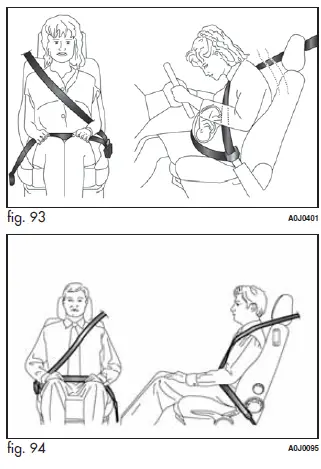
Each seat belt must be used by only one person. Never travel with a child sitting on a passenger’s lap and a single belt to protect them both fig. 95. In general, do not place any objects between the person and the belt.
Caution
- Removing or otherwise tampering with safety belt and pretensioner components is strictly prohibited. Any operations on these components must be performed by qualified and authorized technicians. Always contact Alfa Romeo Authorized Services.
- If the belt has been subjected to high levels of stress, for example after an accident, it should be changed completely together with the attachments, attachment fixing screws, and the pretensioner. In fact, even if the belt has no visible defects, it may have lost its resilience.
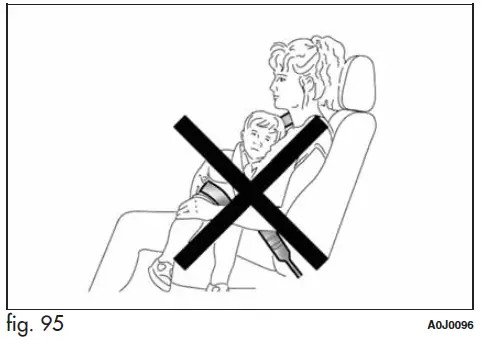
SEAT BELT MAINTENANCE
- Always use the seat belt well stretched and never twisted; make sure that it is free to run without obstructions;
- replace the belt after an accident of a certain severity even if it does not appear to be damaged. Always replace the belt if the pretensioners were deployed;
- hand wash the seat belts with water and neutral soap, rinse, and leave to dry in the shade. Never use strong detergents, bleach, paints or any other substance which could damage the belt fibers;
- prevent the retractors from getting wet: their correct operation is only guaranteed if water does not get inside;
- replace the seat belt when there is wear or cuts.
CARRYING CHILDREN SAFELY
For optimal protection in the event of an impact, all occupants must be seated and wearing adequate restraint systems, including newborn and other children. This prescription is compulsory in all EC countries according to EC Directive 2003/20/EC. Compared with an adult, a child’s head is larger and heavier in proportion to his/her body, and the child’s muscular and bone structures are not fully developed. Therefore, correct restraint systems other than adult seat belts are necessary to reduce as much as possible the risk of injuries in case of an accident, braking, or sudden maneuver. Children must be seated safely and comfortably. As far as the characteristics of the child restraint systems used allow, you are advised to keep children in rear-facing restraint systems for as long as possible (at least until 3–4 years old), since this is the most protected position in the event of an impact. The choice of the most suitable child restraint device depends on the weight of the child; there are various types of child restraint systems and you are advised always to choose the one that is most suitable for the child. When over 1.50 m in height, from the point of view of restraint systems, children are considered as adults and wear seat belts normally.
In Europe the characteristics of children’s restraint systems are ruled by the regulation ECE-R44, dividing them into five weight groups:
| Group | Weight groups | |
| Group 0 | up to 10 kg | |
| Group 0+ | up to 13 kg | |
| Group 1 | 9-18 kg | |
| Group 2 | 15-25 kg | |
| Group 3 | 22-36 kg | |
All restraint devices must bear the type-approval data along with the control mark on a label firmly secured to the child seat which must never be removed.
Lineaccessori Alfa Romeo includes child restraint systems for each weight group. These devices are recommended having been specifically tested for Alfa Romeo cars.
Caution
- SEVERE DANGER. When an active passenger airbag is fitted, DO NOT install rear-facing child restraint systems on the front seat.
- Deployment of the airbag in an accident could cause fatal injuries to the baby regardless of the severity of the impact. It is advisable to always carry children in a child restraint system on the rear seat, which is the most protected position in the event of a collision.
- On the sun visor, there is a label with suitable symbols remembering that it is compulsory to deactivate the airbag if a rear-facing child restraint system is fitted.
- Always comply with the instructions on the passenger’s side sun visor (see the “Front airbag” paragraph).
FITTING “UNIVERSAL” CHILD SEAT (with seat belts)
GROUP 0 and 0+
Caution: The diagram is indicative and for assembly purposes only. Fit the child seat according to the instructions, which must be included.
Infants up to 13 kg must be carried with a child seat facing backward of a type as shown in Fig. 96 which, supporting the head, does not induce stress on the neck in the event of sudden decelerations. The child seat is secured by the car seat belts, as shown in Fig. 96 and it must restrain the child in turn with its own belts.
GROUP 1
Warning: The diagram is indicative and for assembly purposes only. Fit the child seat according to the instructions, which must be included.
Children of weight from 9 to 18 kg may be carried in child seats facing forward Fig. 97.
Caution: Child seats with Isofix attachments are available, which allow them to be secured to the seat safely without using the car seat belts.

GROUP 2
Warning: The diagram is indicative and for assembly purposes only. Fit the child seat according to the instructions, which must be included.
Children from 15 to 25 kg may use the car seat belts directly Fig. 98. In this case, the child restraint system is used to position the child correctly with respect to the seat belts so that the diagonal belt section crosses the child’s chest and not the neck and the lower part is snug on the pelvis, not the abdomen.
GROUP 3
Warning: The diagram is indicative and for assembly purposes only. Fit the child seat according to the instructions, which must be included.
For children between 22 kg and 36 kg, there are dedicated restraint systems that allow the seat belt to be worn correctly. fig. 99 shows an example of correct child seat positioning on the rear seat. Children over 1.50 m in height can wear seat belts like adults.

SUITABILITY OF PASSENGER SEATS FOR UNIVERSAL CHILD SEAT USE
According to the European Directive 2000/3/EC, the suitability of each passenger seat position for the fixing of universal child seats is shown in the following table:
| Group | Weight groups | Front passenger | Rear side and central passenger | |||||
| Group 0, 0+ | up to 13 kg | U | U | |||||
| Group 1 | 9-18 kg | U | U | |||||
| Group 2 | 15-25 kg | U | U | |||||
| Group 3 | 22-36 kg | U | U | |||||
U= Suitable for child restraint systems in the “Universal” category, according to European Standard EEC-R44 for the specified “Groups”.
PREPARATION FOR “ISOFIX” CHILD SEAT
The car is equipped with ISOFIX anchorages, a new standard that makes fitting a child seat quick, simple, and safe. Isofix systems can be fitted alongside conventional child seats on different seats in the same car. An example of a Universal Isofix child seat for weight group 1 is shown in Fig. 100.
Warning: The diagram is indicative and for assembly purposes only. Fit the child seat according to the instructions, which must be included.
The other weight groups are covered by specific Isofix child seats, which can be used only if specifically tested for this car (see list of cars provided with the child seat).
IMPORTANT: The central rear seat is not approved for any type of Isofix child seat.
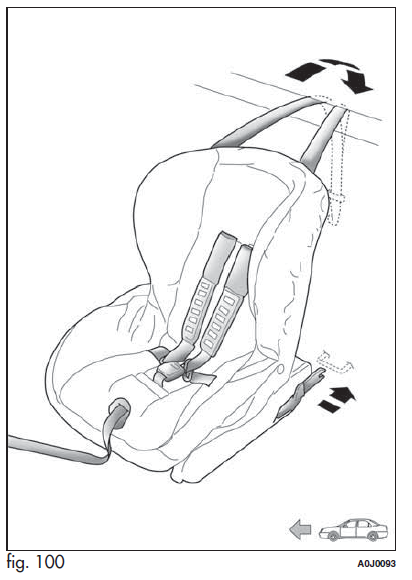
INSTALLING A UNIVERSAL ISOFIX CHILD SEAT
Proceed as follows:
- secure the child seat to the dedicated lower metal rings A fig. 101, positioned between the backrest and the cushion of the rear seat;
- fix the upper belt (available together with the seat) to the special attachments B fig. 102 located in the rear part of the backrest.
It is possible to have a mixed assembly of traditional seats and Universal Isofix ones. Remember that when using a Universal Isofix child seat, you can only use type-approved child seats with the marking ECE R44 (R44/03 or superior) “Universal Isofix”. The universal Isofix “Duo Plus” child seat is available from Lineaccessori Alfa Romeo. For further details on child seat installation and/or use, refer to the instruction manual provided with the child seat.
Warning
- If a Universal Isofix child seat is not fixed to all three anchorages, the child seat will not be able to protect the child correctly. In a crash, the child could be seriously or fatally injured.
- Fit the child seat only when the car is stationary. The child seat is correctly secured to the brackets when you hear the click. Follow the instructions for fitting, removing, and positioning that the manufacturer must supply with the child seat.

SUITABILITY OF PASSENGER SEATS FOR ISOFIX CHILD SEAT USE
The table below shows the various installation possibilities for Isofix child seats on seats fitted with Isofix attachments in accordance with European standard ECE 16.
| Weight group | Child seat position | Isofix size class | Rear passenger | ||||||||
| left side | right side | ||||||||||
| Group 0 up to 10 kg | Facing backwards | E | X | X | |||||||
|
Group 0+ up to 13 kg |
Facing backwards | E | X | X | |||||||
| Facing backwards | D | X | X | ||||||||
| Facing backwards | C | X | X | ||||||||
|
Group 1 from 9 up to 18 kg |
Facing backwards | D | X | X | |||||||
| Facing backwards | C | X | X | ||||||||
| Facing forwards | B | IUF | IUF | ||||||||
| Facing forwards | BI | IUF | IUF | ||||||||
| Facing forwards | A | X | X | ||||||||
X: Isofix position not suitable for child seats in this weight group and/or size class.
IUF: Suitable for Isofix restraint systems to be positioned facing forwards, universal class (fitted with third upper mounting), type-approved for the relevant weight group.
Warning: Fit the child seat according to the instructions, which must be included.
Main recommendations to carry children safely
- Install the child seats on the rear seat, which is the most protected position in the event of an accident.
- Keep children in rear-facing seats for as long as possible, until 2 years old.
- Should a rear-facing child seat be installed on the rear seats, it is advisable to position it as far forward as the position of the front seat allows.
- If the passenger’s front airbag is deactivated always check the permanent switching on of the dedicated warning light on the instrument panel to make sure that it has actually been deactivated.
- Carefully follow the instructions supplied with the child seat itself. Keep the instructions in the car along with the other documents and this handbook. Do not use second-hand child seats without instructions.
- Only one child is to be strapped into each restraint system; never carry two children simultaneously.
- Always check that the seat belts do not interfere with the child’s throat.
- Always check that the seat belt is well fastened by pulling on it.
- While traveling, do not let the child sit incorrectly or unfasten the belts.
- Never allow a child to put the belt’s diagonal section under an arm or behind their back.
- Never carry children on your lap, even newborns. No one can restrain a child in the event of an accident.
- In the event of an accident, replace the child seat with a new one.
FAQ’s
A: To fasten your seat belt, insert the latch plate into the buckle and ensure it clicks securely in place.
A: Most vehicles have three-point seat belts, which consist of a lap belt and a shoulder belt. Some rear seats may have only lap belts.
A: Some models may allow you to adjust the height of the shoulder belt to ensure a comfortable and secure fit. Check for an adjustment feature on the pillar or seat.
A: Yes, all passengers, including those in the rear seats, should wear seat belts for their safety.
A: Position the seat belt across your shoulder and chest, ensuring it lies flat and snug against your body without any twists.
A: If you’re using a child safety seat, make sure to secure the child properly in the seat, and then use the vehicle’s seat belt to secure the child seat in place.
A: Pregnant women should always wear seat belts. The lap belt should be placed low across the hips, and the shoulder belt should run diagonally across the chest and over the shoulder.
A: No, seat belts are designed for one person per belt. Sharing a seat belt can be dangerous and ineffective in a collision.
A: Pull the seat belt to remove any slack while ensuring it is not overly tight or uncomfortable. Adjust the height of the shoulder belt if necessary.
A: Yes, seat belts should be worn at all times, regardless of the trip’s length. Accidents can happen in a split second.
A: Some models may have seat belt reminders that provide audible or visual warnings if occupants are not wearing their seat belts. Pay attention to these reminders.
A: You can clean seat belts with mild soap and water. Avoid using harsh chemicals that could damage the belt material.
A: Never attempt to repair or modify a damaged seat belt. Instead, have it inspected and replaced by a qualified technician.
A: Seat belts may not have a specific expiration date, but they should be replaced if they show signs of wear, damage, or if they have been in a collision.
A: Legal requirements for wearing seat belts vary by location. Always follow the seat belt laws and regulations in your jurisdiction to avoid fines and ensure safety.
Useful Link
View Full PDF: 2015 Alfa Romeo MiTo User Manual | Auto User Guide

